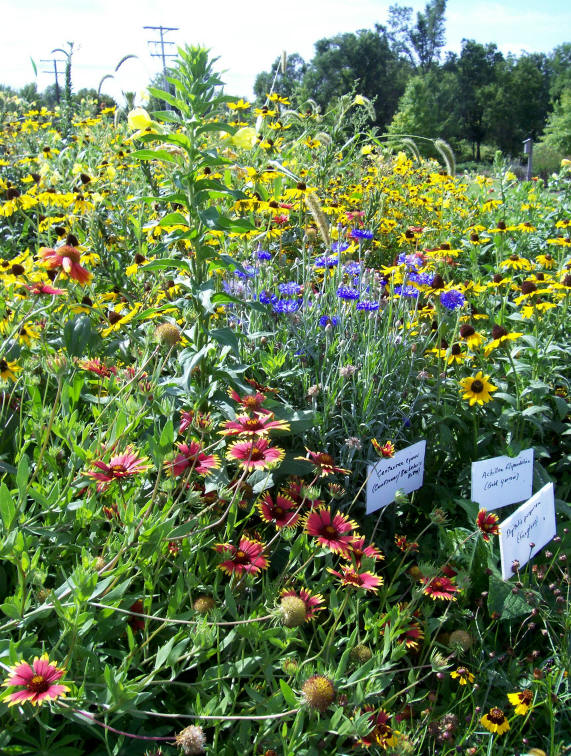Winter - At a mid-winter trial garden committee meeting, it was suggested that we add a bed of wildflowers to the trial garden. The cultivation of wildflowers has become popular and we wanted to learn something of what worked and what didn't. We decided to seed a round bed 40 feet in diameter.
April - The bed was laid out and marked, and we quickly noticed that it looked substantially more formidable on the ground than it sounded in the early discussions. However, we forged ahead and killed the existing grass and prepared to plant a mix of annual and perennial wildflowers suited to this
area.

We included:
| Annuals |
Perennials |
- Baby's Breath
- Catchfly
- Cornflower
- Corn Poppy
- Dwarf Red Plain's Coreopsis
- Evening Primrose
- Indian Blanket
- Plains Coreopsis
- Rocket Larkspur
- Scarlet Flax
|
- Black-eyed Susan
- Blanketflower
- Blue flax
- Dame's Rocket
- Foxglove (biennial)
- Gold Yarrow
- New England Aster
- Lupine
- Purple Coneflower
- Shasta Daisy
- Tickseed
- Wallflower
|
May - We seeded the bed in mid-May. The seeds were sown directly on the soil, lightly covered with peat moss and watered in. In the two weeks following seeding we had 6.6 inches of rain and were seeing our first seedlings. Unfortunately, the weeds appeared even more quickly and grew faster. After
four weeks the bed was completely green.
June - Decisions, decisions! Something had to be done about the weeds, which were fast taking over the bed. The catalog for the wildflowers states in capital letters to have PATIENCE, but at this point we felt we had to address the weed issue. Trying to eliminate weeds without disturbing the
wildflower seedlings presented several difficulties. First, due to the size and shape of the bed, it was impossible to reach far beyond the edges without risking stepping on young seedlings and compacting the soil. Second, we could identify some of the weeds and some of the flowers, but we still had many that we could not
yet identify. Third, when pulling a weed, there were often wildflower seedlings that came out with it. To our amazement and delight, we did find Corn Poppy, Cornflower and Rocket Larkspur blooming among the weeds.
July & August - We continued to pull as many weeds as we could, trying to do minimal damage. We tried different approaches in our attempt to come up with a good formula. We tried staying in one spot and pulling every weed within reach. We tried identifying particularly large and troublesome weeds
such as Lambsquarter and Ragweed and attacking them. We left the Purselane alone as it is low growing and provides some cover for young seedlings. We left 1/8 of the bed unweeded as a control for comparison.
The perennials blooming at this point were Blanket flower, Black Eyed Susans, Tickseed, Wallflower, and Dame's Rocket. All of the annuals had bloomed with the exception of Baby's Breath & Blue Flax. The most determined of the weeds were ragweed, purslane, lambsquarter and assorted grasses.
September & October - Black Eyed Susans, Blanket Flower and Evening Primrose dominated the bed at this point. We were delighted to see a mass of yellow and orange, perfect for fall, as well as a touch of blue from Cornflowers. We did pull the weeds from the control section as they were going to seed
and we didn't want to add to next year's weed challenge. We also pulled Evening Primrose which is called a wildflower in our mix, but a weed in Weeds of the Northeast. It was too aggressive and we didn't want it to crowd out flowers we felt were more desireable.
As this is written in late October our job is not quite finished for the year. The rule of thumb is that when dead, brown foliage offsets floral color display, the area can be trimmed. We will mow the area to a height of 4-6 inches. Possibly two cuttings will be needed to thoroughly break up the
resulting stem and leaf litter. Annual mowing aids in seed dispersal, reduces competition of unwanted weeds and grasses and allows sufficient sunlight to penetrate to the lower growing plants and seedlings. We have had approximately five inches of rain Oct. 1-9 giving us a total of 22.5 inches for the summer. This will be
good for the plants going into winter.
Now we will only have to evaluate our results and plan for next year. Overall, we are pleased with the results at this point. From late June until Oct. 20th when we had frost there were many flowers blooming. We did have some bare spots, and are planning to add some individual seeds in the spring.
Weeding remains the biggest question. Next year we may not weed quite as early giving seeds that are slow to germinate a better chance to germinate and get established. In conclusion, growing wildflowers can be a satisfying project, but we can't suggest going into it thinking that you can just sow the seeds and sit back
and enjoy. Stay tuned for year two.
Read other articles on ecological gardening & native plants
Read other articles on garden and landscape design
Read other articles by Martie Young